Aviation against tanks (part of 9)
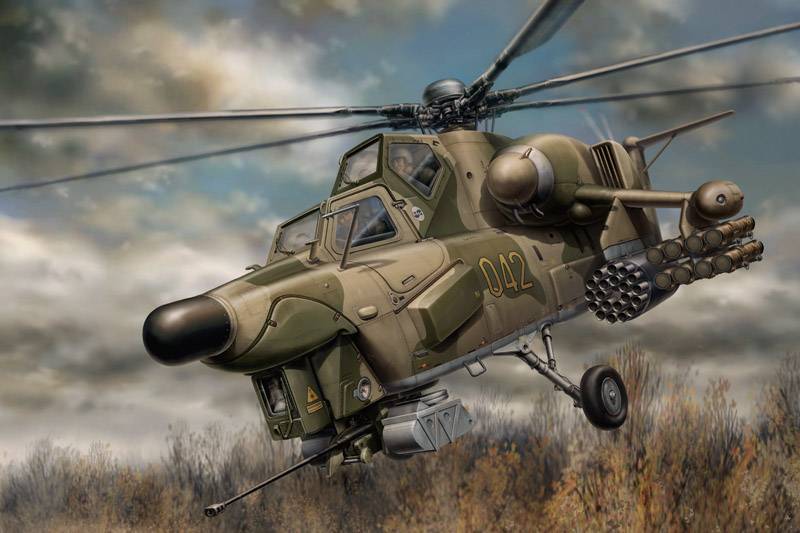
By the second half of the 70-s in the USSR, there was already a noticeable number of combat helicopters Mi-24, and the military had gained some experience in their operation. Even in the ideal conditions of the exercises, it was problematic to use the “twenty-fours” at the same time for conducting fire support and landing troops. In this case, the helicopter was overloaded and was ineffective in the role of attack aircraft, and the Mi-8TV was hopelessly lost in terms of transport capabilities. Thus, the generals were forced to admit that the concept of “flying BMP”, which was extremely attractive in theory, turned out to be difficult to implement in practice. The Mi-24 helicopters of all modifications clearly lacked the thrust-to-weight ratio, while the landing bay during most combat missions was a useless ballast.
Even at the design stage, the designers of the Mil Design Bureau considered several variants of a combat helicopter, including those without a cargo-passenger compartment. Shortly after the start of work on the Mi-24, a full-size model of a combat helicopter was built as part of the design of the “280 product” in 1970, which was a variant of the Mi-24 without an airborne cargo cabin and with reinforced armament.
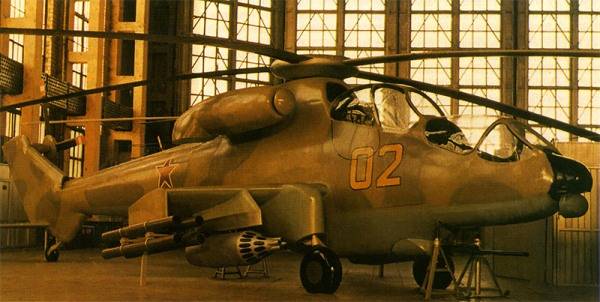
However, the other extreme was the version of the twin-screw transverse helicopter. According to preliminary calculations, under the wing of a large elongation, it was possible to place a combat load of approximately twice that of the Mi-24.
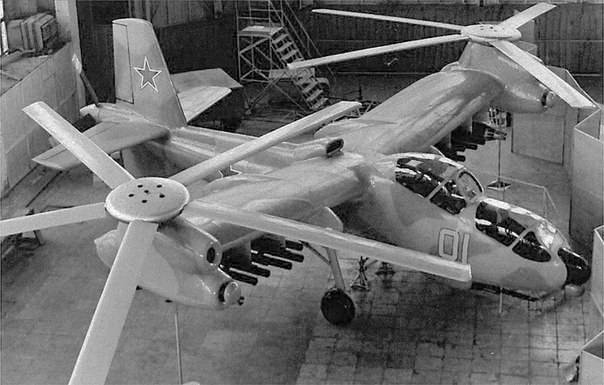
This scheme gave certain advantages over the classic-style helicopter, but a significant increase in payload could only be obtained during takeoff with a takeoff. In addition, the weight and dimensions of the helicopter significantly increased, as well as its vulnerability, which was ultimately considered unacceptable. Also considered various options for high-speed attack helicopter, with a rigidly fixed main and additional pushing propeller.
Subsequent understanding of domestic and international experience has shown that the classical scheme is still the most acceptable scheme for a combat helicopter. Due to the congestion of the "Milevsky" design bureau, the further design of the "280 product" stalled, and the "Kamovsky" version of the Ka-25F combat helicopter, which was mentioned in the previous part of the review, did not arouse military interest.
However, information about the development of new types of anti-tank helicopters in the US seriously concerned the Soviet leadership, and 16 December 1976 of the year issued a decree of the CPSU Central Committee and the USSR Council of Ministers on the development of a new-generation combat helicopter. When designing advanced combat helicopters, the designers of Mil and Kamov Design Bureau took into account the experience of creating and using the Mi-24. On the projects of new cars there was a rejection of the useless landing cockpit, due to which it was possible to reduce dimensions, reduce take-off weight, increase thrust-to-weight ratio and combat load.
In the second half of the 70s, the main characteristics of a promising combat helicopter were determined: the maximum speed of up to 350 km / h, a static ceiling of more than 3000 m, a combat radius of 200 km, a combat load of at least 1200 kg. In terms of maneuverability and rate of climb, the new combat vehicle was to surpass both the Mi-24 and helicopters of a potential enemy. Reservation was carried out with the condition of ensuring the protection of the main units from armor-piercing bullets of 12,7 mm caliber, and the crew cabin from 7,62 mm bullets. The helicopter was supposed to serve not only as a means of fire support for ground units on the battlefield, but also had advanced capabilities to combat tanks and other armored vehicles, escort transport helicopters, fight enemy helicopters and be able to conduct defensive air combat with fighters. It was proposed to use the Sturm anti-tank guided missiles and a 30-mm cannon on a movable turret as the main weapons for fighting armored vehicles.
Subsequently, the customer revised his requirements in terms of speed characteristics, reducing the maximum speed to 300 km / h, and the desired weight of the maximum combat load, on the contrary, was increased. The layout of the main units was to provide quick access to them in the field, this was tied to the requirement of autonomy for conducting combat operations from sites outside the main aerodrome during 15 days. In this case, the labor costs in preparation for the re-combat sortie, compared with the Mi-24, should have been reduced three times. As a starting point, the Milovians took the capabilities of their own Mi-24 and advertising characteristics of the American AN-64 Apache, which was to be surpassed by the basic data.
When creating the helicopter, which received the designation Mi-28, the designers, who understood that the saved kilograms can be used to increase the combat load and increase security, starting from the experience of creating a “flying BMP”, paid much attention to weight perfection. It was decided to ensure combat survivability by duplicating the most important components and assemblies with their maximum separation, as well as shielding the more important ones with less important ones. Fuel lines, hydro and pneumatic lines are duplicated. Two engines are separated and screened by the airframe design elements. Much work was done in creating a combined protection, selection of materials, layout and placement of nodes, with the exception of catastrophic destruction of power structures in case of combat damage. As in the later versions of the Mi-24, the Mi-28 fuel tanks were protected and protected from the explosion by polyurethane. Since the “shoulder to shoulder” crew layout did not provide optimal viewing angles for the pilot and operator, it made it difficult for the helicopter to crash and created prerequisites for the simultaneous disabling of the entire crew, using the “tandem” circuit, starting with the standard Mi-24D modifications.
When designing helicopter units, various variants of schemes and design solutions were worked out, new materials were widely introduced. So on special stands several variants of the steering and main rotor and new bushings were tested. Promising design solutions were tested on flying laboratories created on the basis of the Mi-8 and Mi-24. In practice, not only constructive solutions, new components and assemblies, as well as onboard electronic equipment: the autopilot, sight-sight complex and armament were tested. To test the layout of the helicopter 6 was built full-size layouts. Very serious studies have been carried out to ensure the safety of the crew in the event of a helicopter hitting due to the introduction of elements of the passive protection system, means of emergency depreciation and chassis fixation, impact-resistant seats, a movable floor. The system of passive protection of the helicopter had to ensure the survival of the crew during an emergency landing at a vertical speed of up to 12 m / s.
In order to reduce vulnerability from infrared homing missiles, much attention was paid to reducing thermal visibility. Protection against destruction by guided missiles was provided by the equipment for jamming in the millimeter and centimeter radio frequency range, an optoelectronic countermeasure station and heat traps. Also, the helicopter was supposed to be equipped with warning equipment for radar and laser irradiation.
The prototype of the combat helicopter Mi-28 was built according to the classic single-rotor scheme. In its nose part there was an armored cockpit with two separate protected compartments of the weapon operator and pilot. The cab's armored protection consisted of 10-mm aluminum armor plates, on top of which 16-mm ceramic armor tiles were additionally glued. Damaged armor elements can be replaced. The crew was divided among themselves 10-mm armored partition. Cabin glazing is made of silicate bulletproof glass. Cabin windshields are blocks of transparent armor 42 mm thick, and side windows and door windows are made of the same blocks, but 22 mm thick. The plane-parallel glazing of the cab withstands direct hits of armor-piercing bullets of 12,7-mm caliber into frontal glasses and bullets of 7,62-mm caliber into side glasses, the hull armor is capable of holding single hits of 20-23-mm high-explosive incendiary projectiles. The door of the weapons operator, who also performs the duties of the navigator, is located on the left side, and the pilot - on the right. For an emergency escape from the cabin, doors and glass had emergency reset mechanisms. Under the doors, special ladders were inflated, protecting the crew from hitting the chassis. From the bottom of the nose, on the stabilized platform, a combined observation and sight station and a cannon mounting unit are mounted. The electronic components of the avionavigation unit were located under the cabin floor.
According to the approved technical task on the Mi-28, the avionics were to be installed, allowing piloting and carrying out the combat mission at any time of the day and in adverse meteorological conditions. In the operator’s cab, the weapons were mounted on the control equipment of the anti-tank missile system and the sight-and-sight system for searching, recognizing, and tracking a target when launching guided missiles and firing a gun. At the disposal of the pilot there is a helmet-mounted system that provides control of the gun and the aim flight-navigation system PrPNK-28.
Unlike the Mi-24, the tricycle landing gear with a tail wheel on the Mi-28 was made non-retractable. This increased frontal resistance, but allowed us to increase the helicopter’s weight perfection and increase the crew’s chances of survival during an emergency landing. The chassis design includes energy absorbing hydropneumatic shock absorbers with an additional emergency course. The main support lever type provide an opportunity to change the clearance of the helicopter.
The power plant consisted of two turboshaft engines TV3-117ВМ, horsepower 1950. Each engine had the ability to work independently, due to which flight was provided when one engine went out of order. The auxiliary gas turbine powerplant АИ-9В power 3 kW was used for power supply in field conditions and quick start of the main engines. For the new combat helicopter, a five-blade main rotor was created from scratch using polymer composite materials. The rotor had the same diameter as the Mi-24, but the blades with a profile with an increased curvature, create a large lifting force. The elastomer rotor hub, which does not require constant lubrication, allowed for increased maneuverability and reduced maintenance costs. According to the terms of reference, the screw was supposed to withstand the backache of 30-mm projectiles.
For the first time in the USSR, an X-shaped four-blade tail rotor was used on the Mi-28. This type of screw allows to reduce noise and increase efficiency. But because of the design of the tail rotor, on the first prototypes, the steering screws from the Mi-24 were used. The blades of the main and tail rotors are equipped with an electric anti-icing system.
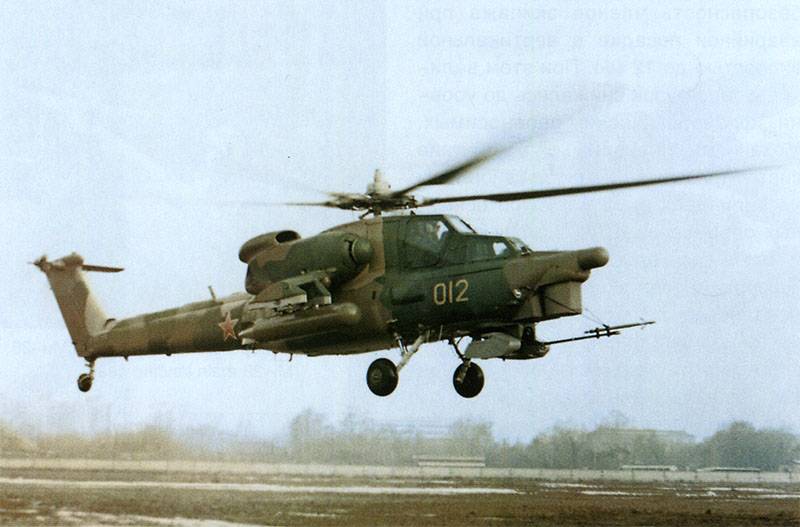
The Mi-28 prototype took off the ground on 10 on November 1982 of the year. The first prototype of the helicopter was not carrying guided weapons and was intended to remove the flight performance. Tests of weapons and PrPNK began on the second copy at the end of 1983 year. By 1986, the main declared characteristics were confirmed, and for a number of parameters they were able to exceed. Since the helicopter compared with the Mi-24 had significantly greater maneuverability, the military expressed a desire to expand the range of permissible overloads. This was carried out after a corresponding refinement of the hydraulic system and blades. In 1987, we managed to bring the X-shaped tail rotor, after which the appearance, equipment and characteristics of the Mi-28 were finally determined.
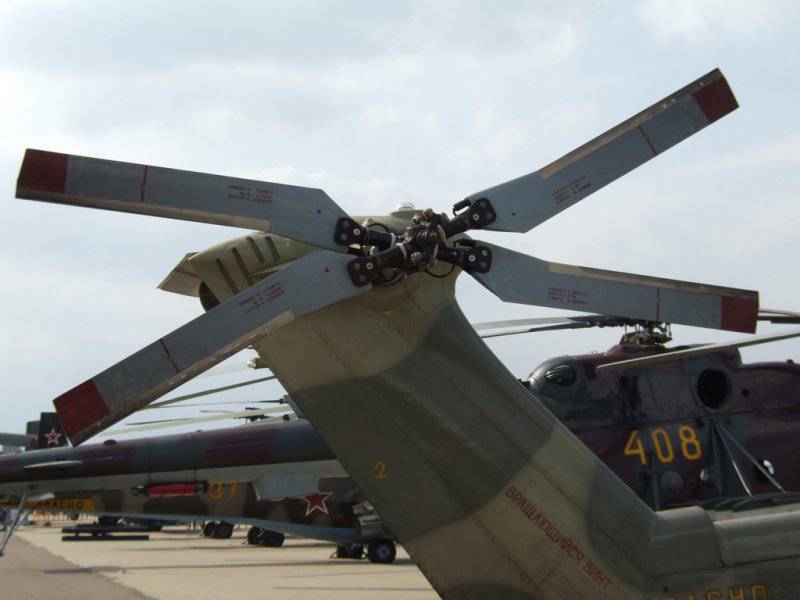
A helicopter with a maximum take-off weight of 11500 kg could take on board a combat load of about 2000 kg. The mass of fuel - 1500 kg. Maximum speed - 282 km / h. Cruising - 260 km / h. Static ceiling - 3450 m.
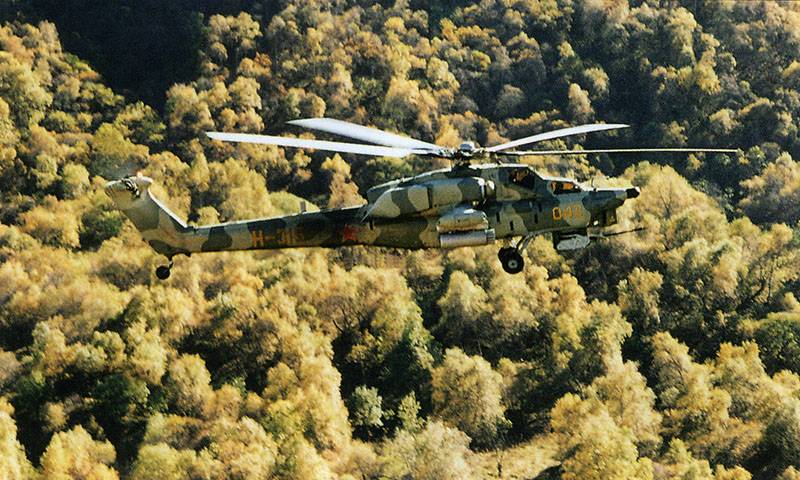
At the beginning of 1988, the tests of the modernized Mi-28A began. His first public screening took place in 1989 at the aviation festival in Tushino. During the tests, the Mi-28A demonstrated increased flight and combat capabilities. The upgraded combat helicopter could perform aerobatics: “barrel” and “Nesterov’s loop”.
In the comments to the parts devoted to the Mi-24 and Ka-29, there were allegations that, unlike the NATO countries, the Soviet Union did not need an anti-tank helicopter because of its overwhelming superiority in tanks. Say, therefore, on the Mi-24 emphasis was placed on the use of unmanaged means of destruction. but story the appearance of the anti-tank attack aircraft Su-25T and the pronounced anti-tank specialization of promising combat helicopters indicates that the Soviet top military-political leadership considered different scenarios in possible conflicts, and therefore did not refuse to create flying tank destroyers.
Soviet combat helicopters of a new generation thanks to the use of a rotor with high efficiency in the hover mode, improved maneuverability at low speeds, the use of sighting and viewing stations that allow you to detect, take to escort in automatic mode and use weapon from the maximum distance, we got the opportunities inaccessible for earlier Mi-24. In contrast to the heavy-duty “twenty-fours”, the Mi-28 under combat conditions could freely hang on the spot, bounce vertically over obstacles, move sideways and even back. The capabilities of the helicopter made it possible to move along hollows, ravines, the bed of small rivers at extremely low altitude. Everything allowed to quickly take the optimal position for the use of guided anti-tank missiles and evade enemy ground-based air defense weapons.
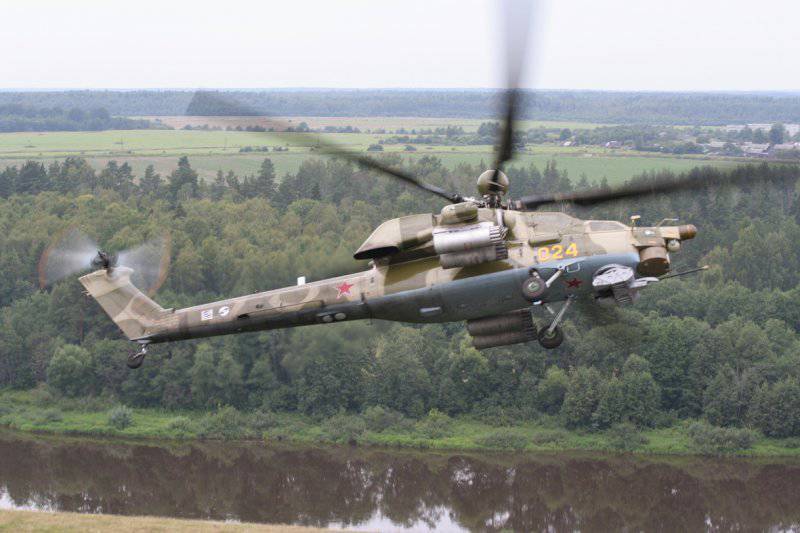
The use of armament was provided by an automated combined overview and sighting system on a gyro-stabilized platform with high resolution and viewing angles: 110 ... 110 ° in azimuth and + 13 ... -40 ° in elevation. In the daytime, two optical channels with a wide (3-x multiples) and narrow fields of view (13-multiples) can be used. At a low level of illumination, an optical television channel is used with 20-ti multiple magnification. Laser rangefinder-pointer determines the current distance to the target. His data are used by the onboard computer to calculate the corrections when firing from a cannon, launching the NAR and when using an ATGM.
The standard set of weapons Mi-28 also demonstrates its pronounced anti-tank orientation. So from the very beginning the helicopter used the “Whirlwind” ATGM with a laser guidance system as a “main caliber”. Although in the future, for a number of reasons, this idea was abandoned, the main arsenal for fighting armored vehicles still inspires respect - until the 16 ATGM “Shturm-V” or “Attack-B”. The radio command transmission antenna is located in the nose of the helicopter, and the elongated antenna cowling gives the Mi-28 a distinctive, easily recognizable appearance.
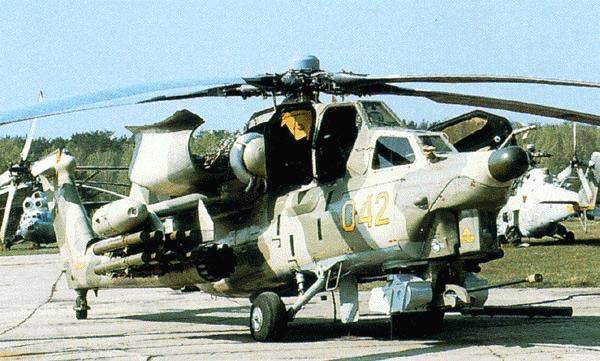
The rest of the helicopter armament also leaves no doubt what it was mainly intended for. But the possibility of using such an effective Mi-28 with strikes on areal targets of weapons like the NAR, of course, has been preserved.
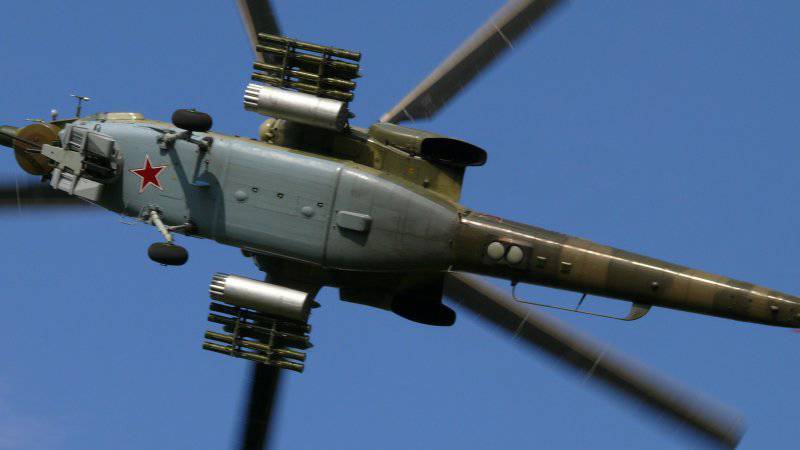
However, the number of suspended units compared to the "attack aircraft" Mi-24 reduced by half. The ability to equip additional launchers for unguided missiles is available, but only at the expense of abandoning the ATGM.
Otherwise, the range of weapons Mi-28 is the same as in the later versions of the Mi-24. In addition to ATGM and NAR: R-60М short-range air combat, 23-mm suspended cannons, 30-mm automatic grenade launchers, 12,7 and 7,62-mm machine guns, KMGU-2 containers, bombs weighing up to 500 kg and incendiary tanks.
The 30-2 42-mm mobile cannon can be driven at high angular speed. The angles of aiming of the electric drive of the gun correspond to the viewing angle of the OPS. The drive of the gun installation is electric. The gun is powered from ammunition boxes attached to the turret on both sides. Depending on the nature of the target, the crew can choose the type of projectile (armor-piercing or high-explosive fragmentation) directly during the performance of the combat mission.
In 1993, after passing the first stage of state tests of the Mi-28A, it was decided to prepare it for mass production. However, in the conditions of the emergence of a “market economy”, a “shock therapy” and political instability, there was no money for this in the “new Russia”. The future of the helicopter was “stuck in the air”; in the absence of orders from its own armed forces, foreign buyers were not in a hurry to acquire a very promising, but not serial, vehicle. In addition, the customer represented by the Ministry of Defense of the Russian Federation clearly favored another combat helicopter - a single Ka-50, which was a very serious competitor.
By the second half of 90-x there was a lag from the main foreign counterpart - the American AH-64D Apache Longbow. The Americans relied on the use of millimeter-range airborne radar and modern optoelectronic systems and weapon control processors. This was to significantly expand the capabilities of the helicopter at night and in bad weather conditions, increase the crew’s informational awareness, reduce the time of preparation for the use of weapons, increase the number of simultaneously fired targets and implement the “fired and forgotten” mode of using an anti-tank missile. In this situation, the management of the OKL named after M.L. Mile decided, on an initiative, to develop an all-daily modification of the Mi-28H “Night Hunter” combat helicopter using the cross-section antenna of the Arbalet radar system operating in the millimeter-wave range.
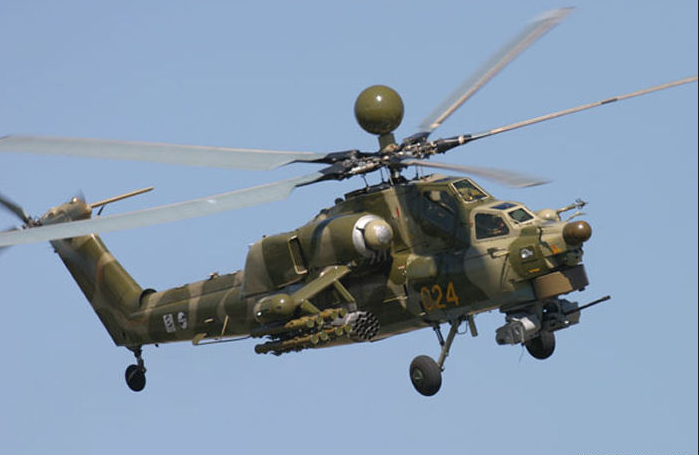
According to data published in the domestic media, the Arbalet RLC weighs about 100 kg. In the earth viewing mode, the radar is able to detect a tank at a distance of 12 km, an armored vehicle column from a distance of 20 km. In the mapping mode and during flight with the rounding of the irregularities of the earth's surface, power transmission lines are detected at a distance of 400-500 meters, and the relief with a slope of more than 10 ° is 1,5 km.
When working on aerial targets is a circular viewing space. An aircraft of the Su-25 dimension can be detected at a distance of 15 km, which, given the introduction of the P-73 air combat into the UR helicopter arsenal, significantly increases the chances of winning the air combat. The radar also records rockets attacking the helicopter: for example, the FIM-92 Stinger SAM missile detects the equipment at a distance of 5 km. Reaction time when working on aerial targets - 0,5 with. The radar system is capable of simultaneously accompanying up to 20 ground or air targets.
However, it was clear that the use of the RLC alone would not solve the problem of a sharp increase in combat effectiveness and ensuring daily use. Optical and thermal imaging sensors, as well as the on-board locator, are integrated into a single control system using computational tools. At the same time, the equipment of the cabin and means of displaying information have undergone cardinal processing. At the disposal of the pilot and the operator of the armament there are three multifunctional liquid crystal displays. The cartographic information on the terrain of the combat area is loaded into the digital data bank and with a high degree of resolution forms a three-dimensional image of the area where the helicopter is located. The location of the helicopter with high accuracy is determined by the signals of the satellite positioning system and using an inertial navigation system. The complex of onboard equipment Mi-28H provides piloting around the terrain, both in manual and automatic mode, and allows you to work at altitudes 5-15 m.
The airborne communications complex exchanges information (including in closed mode) with the command posts of the ground forces, as well as between the helicopters in the group and other consumers who possess the necessary communications equipment. The crew of the helicopter also has the ability to receive external target designation.
The security of the Mi-28H is at the level of the Mi-28А, but its design introduced measures to reduce radar, visual and thermal conspicuity, as well as to reduce noise, which should reduce the vulnerability of ground-based air defense systems.
Due to the presence of a radar with a supra-sleeve antenna, the crew of the Mi-28H has the ability to search for targets, avoiding visual detection by the enemy. By setting up the “crown of the antenna” because of the natural shelter on the ground (hills, treetops, buildings, etc.), you can secretly search for targets, not only for yourself, but for other machines participating in the attack. Having marked the objects of impact, the combat helicopter carries out an energetic “jump” and conducts an attack with supersonic ATGM. A number of domestic sources say that thanks to the Arbalet radar, the Ataka-V missiles with a radio command guidance system can be used around the clock in the “released and forgotten” mode, but it is hard to say how true this is.
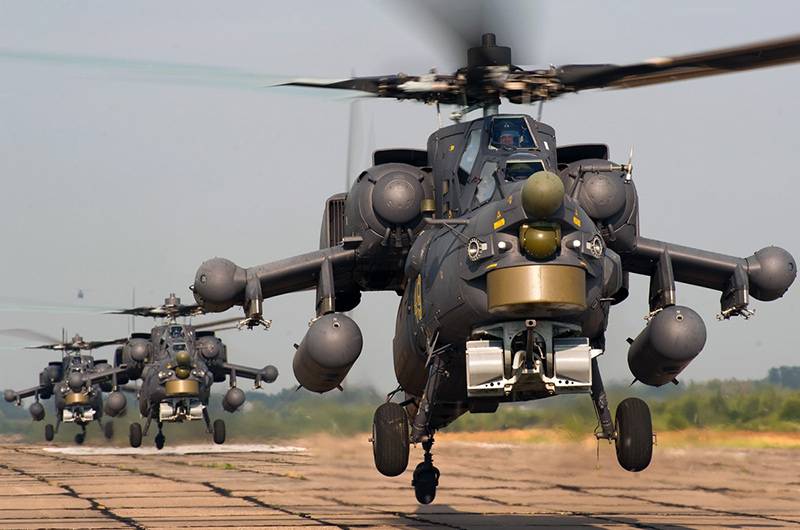
The armament of the “Night Hunter” is generally similar to the Mi-28А, but thanks to the updated avionics, the combat capabilities of the helicopter have increased significantly. But, apparently, the station "Crossbow" are not installed on all Mi-28H. There are many photographs of combat vehicles on which there is no radar antenna bobbin.
During the creation of the Mi-28H, the designers were faced with the problem of maintaining high helicopter flight performance under conditions of a sharp increase in functional load. It was necessary not only to give the helicopter “all-day”, the possibility of flying around the terrain, to increase the search and prospecting qualities, but also to maintain high maneuverability. Figures of aerobatics - barrels and coups with a subsequent reversal, not only look spectacular at the air show, but also allow you to dodge the enemy's attack and take an advantageous position in air combat.
As a result, developers managed to realize their plans without losing flight data. The normal operational overload of the Mi-28H is 3g, which is a lot for the helicopter. The helicopter is capable of: looping Nesterov, Immelman's coup, barrel, flying sideways, backward, sideways at speeds up to 100 km / h, turning at angular speeds up to 117 degrees / s, with a maximum angular speed of heel more than 100 degrees / s. The maximum take-off weight of the Night Hunter increased to 12100 kg, to compensate for this, Ukrainian-made TV3-117ВМА engines with a power of 2200 hp take-off mode were installed on the helicopter.
After the collapse of the USSR, it turned out that the production facilities for the construction of helicopters remained in Russia, and the production of engines for them in Ukraine. At the beginning of 2000-s in Russia, they decided to create their own fully independent production of helicopter engines on the basis of OAO Klimov. In 2011, a new aircraft engine plant was laid out near St. Petersburg, and in 2014, the first line of the plant was commissioned. Since relatively recently, Russian VK-28P engines with a take-off power of 2500 l have been installed on Mi-2400H under construction. with. and with reduced specific fuel consumption. Emergency mode allows you to remove 2,5 horsepower XN for 2800 minutes. VK-2500P engines are equipped with a modern electronic control system and fire protection. Thanks to the introduction of new design solutions, increased reliability of operation in high-temperature and high-altitude conditions is ensured.
With VK-2500P engines, the maximum speed of the Mi-28H is 305 km / h. Cruising - 270 km / h. Weight of combat load - 2300 kg. Rate of climb - 13,6 m / s. Static ceiling - 3600 m. In domestic sources, the indicated practical range of flight ranges from 450 to 500 km. In this case, the combat radius of action must exceed 200 km.
The Mi-28N helicopter first flew on November 14, 1996. In 2005, a contract was signed for the supply until 2013 of 67 Mi-28N helicopters. The first Mi-28N from the pre-production party was handed over to the armed forces on June 5, 2006. The first 4 Mi-28Ns of serial construction were delivered to the Combat Use and Retraining Center of the Army aviation in 2008. According to foreign military directories, as of 2016, the Russian Armed Forces had more than 90 Mi-28Ns and combat training Mi-28UBs.
Improvement of the Mi-28H continues. Russian media reported that in July, the 2016 of the year began flight tests of the Mi-28HM helicopter (product 296). While preserving the main structural elements, the main part of the avionics was subjected to processing. The most noticeable external difference is the absence of a guided missile guidance station on a new car with a nose fairing. There is information according to which an anti-tank guided missile with a laser beam will now enter the helicopter’s arsenal. For this purpose, the range finder can be used, which is present in the composition of the optical-electronic survey station. According to other data, ATGMs can be equipped with a semi-active radar guidance system. This will increase the noise immunity and may increase the number of simultaneously fired targets. The detection and illumination of targets will be made by the H025 radar with the antenna placed in a spherical nadvtulochny fairing. It is reported that locators are planned to be mounted on all production Mi-28HM helicopters.
The avionics of the new helicopter includes a helmet-mounted target designation and display system with stereovision. It is designed for operational guidance of onboard armament by turning the pilot's head. The image from the vision system (including the aiming mark) is projected onto the screen mounted on the pilot's helmet, and does not interfere with the visual control of the external situation.
For the first time in domestic practice, on all Mi-28HM serial helicopters, in addition to the traditional radar jamming station and the heat trap equipment, it is planned to use a laser anti-missile system with IR GOS. Survival will also increase the presence of controls in the cockpit of the navigator-operator, he will be able to take control of the machine and return to the airfield in case of pilot failure.
It is possible that the changes will affect the artillery of the helicopter. Earlier, representatives of the design office have repeatedly stated the need to install a new, lighter and more accurate 30-mm gun on the helicopter. State tests of a modernized Mi-28HM combat helicopter were planned to begin at the end of 2017.
The first buyer of the Mi-28HE was Iraq, which ordered 2012 helicopters in 15 year. A modification of the Mi-28HE has been developed for export deliveries. Contrary to popular belief, export vehicles do not have “curtailed” combat characteristics and differ from those in service in the Armed Forces of the Russian Federation by means of communication and the state identification system. The export price of the Mi-28HE is not officially disclosed, but according to expert estimates it is $ 18-20 million, which is about 2,5-3 times less than the cost of AH-64D Apache Longbow (Block III).
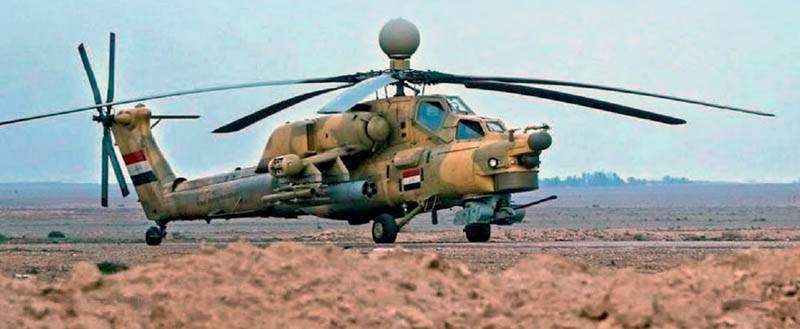
In accordance with the wishes of foreign customers, the Mi-28НЭ is completed with dual controls, allowing piloting from the cab of the navigator-operator and the radar with the antenna booster.
Algeria was even more fastidious customer. The combat helicopters destined for this country are equipped with new-generation H025E radar stations and a laser anti-man-portable air defense system, which is not yet in the Russian armed forces. In March, 2014, Algeria ordered the 42 Mi-28НЭ, the first batch of helicopters has already been transferred to the customer.
Despite the fact that the Mi-28H is relatively recently put into service and not too much built, the helicopter has already managed to positively establish itself in combat. Iraqi Mi-28HE and Mi-35M are actively involved in the fighting against the Islamists. Combat helicopters of the Iraqi army provided substantial support to ground units during the battle for Mosul and attacked enemy positions in the area of Fallujah. According to statements by Iraqi representatives, unguided means of destruction were used, as a rule, mainly 80-mm NAR C-8. After the launch of unguided rockets, shelling was often conducted from 30-mm guns. The objects of attacks of military helicopters were various fortifications and defense units, artillery and mortar positions and places of accumulation of manpower. Guided missile weapons were used relatively rarely, the targets for the ATGM were mainly various vehicles and pick-ups with weapons. In some cases, guided missiles were used for individual firing points and observation points. Combat flights of "Night Hunters" were carried out mainly in the daytime, night flights were sporadic. Thus, it can be stated that, taking into account the primary use of NAR, the combat effectiveness of the Mi-28HNE, on which very advanced avionics are installed and the ability to operate effectively at night, is approximately at the same level as the Mi-35М. Such use of modern combat helicopters is irrational, and, most likely, is a consequence of the low level of planning of combat operations and poor training of Iraqi crews.
In March 2016, the Russian Air Force Aviation Group in Syria was reinforced by several Mi-28Н. After the announcement of the withdrawal of a part of the Russian aviation group, these vehicles joined in with the direct support of the Syrian government forces. Soon after, cadres of combat use of anti-tank missiles from Mi-28H helicopters against Islamist armored vehicles in the Syrian Palmyra region were published. Also on the record there are frames with the destruction of the building, in which the militants took refuge. Unlike Iraqis, our crews, along with the NAR and cannons, actively used guided missiles, including at night.
Unfortunately, it was not without flight accidents. 12 April 2016 crashed during the night flight Mi-28H, both crew members died. It is reported that the helicopter was not fired, but crashed in conditions of poor visibility due to the loss of spatial orientation of the pilot. The following incident with the "Night Hunter" in Syria happened October 6 2017 of the year. In the province of Hama, when performing the task of escorting the Mi-8 helicopter, due to a technical malfunction, the Mi-28H helicopter made an emergency landing, while the crew was not injured. Inspection of the helicopter showed no fire impact from the enemy.
Currently, the life cycle of a combat helicopter Mi-28, in fact, is just beginning. The economic turmoil and the lack of attention in the past of those in power to their own armed forces prevented them from establishing large-scale production and accumulating sufficient experience in operating modern helicopter equipment. Therefore, on “Mi-28Н” “children's sores” are still not cured, and its reliability and time to failure is still worse than that of Mi-35М. It can also be noted that the guided weapons and a number of on-board electronic systems, developed in Soviet times, no longer fully meet modern requirements. However, all this is completely solved: with the political will and the allocation of the necessary resources, the new modifications of the Mi-28 are able to meet the highest international standards and make a worthy competition to the combat helicopters of "likely partners."
To be continued ...
Based on:
https://bmpd.livejournal.com/2248535.html
http://www.telenir.net/transport_i_aviacija/boevoi_vertolet_mi_28/p4.php
https://militaryarms.ru/voennaya-texnika/aviaciya/mi-28/
http://www.russianhelicopters.aero/ru/helicopters/military/mi-28n.html
http://www.airbase.ru/alpha/rus/a/arbalet/
http://army-news.ru/2015/12/v-boevyx-dejstviyax-protiv-bandformirovanij-vertolety-nezamenimy/
https://www.ainonline.com/aviation-news/defense/2016-07-05/iraq-using-mil-mi-28-attack-helicopters-against-daesh
The Military Balance 2016
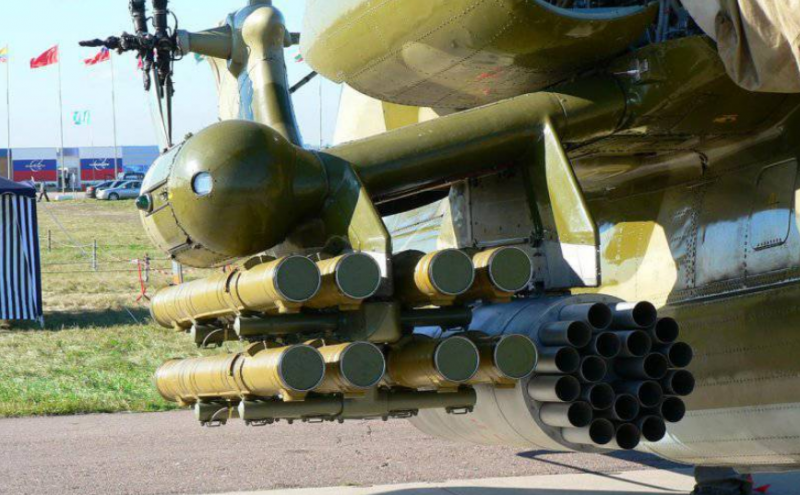
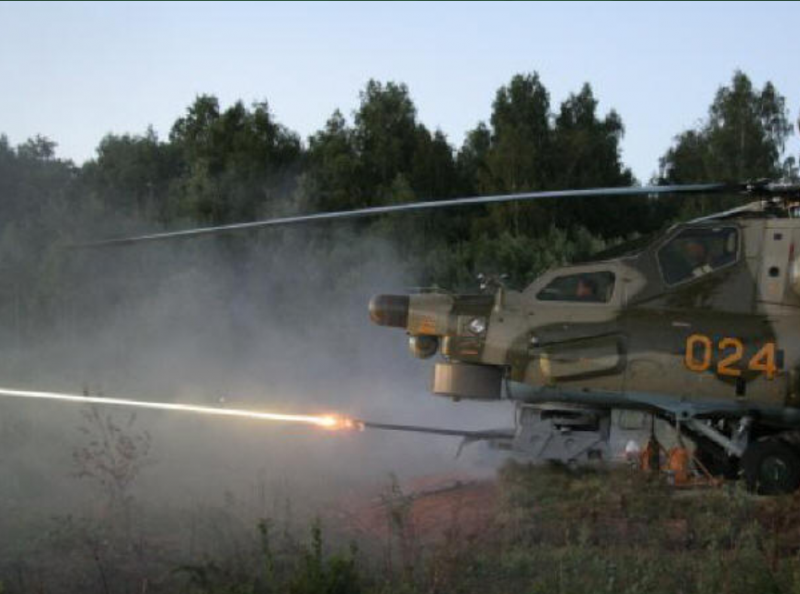
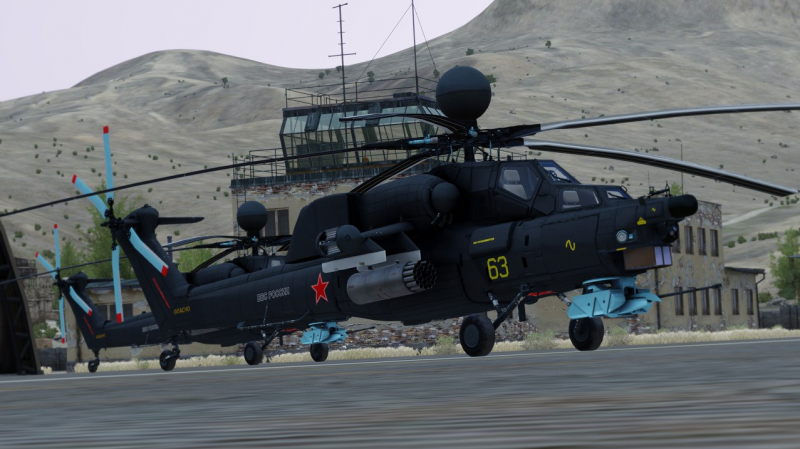
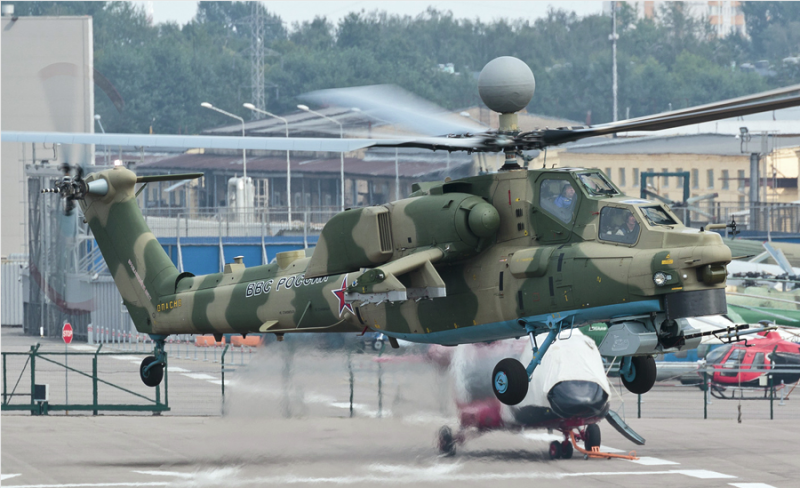
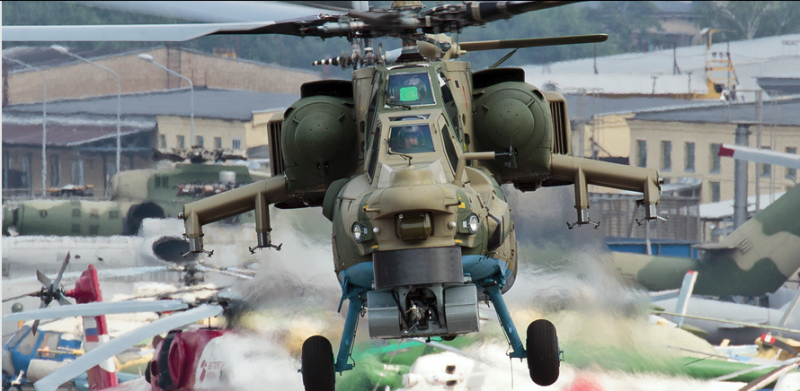
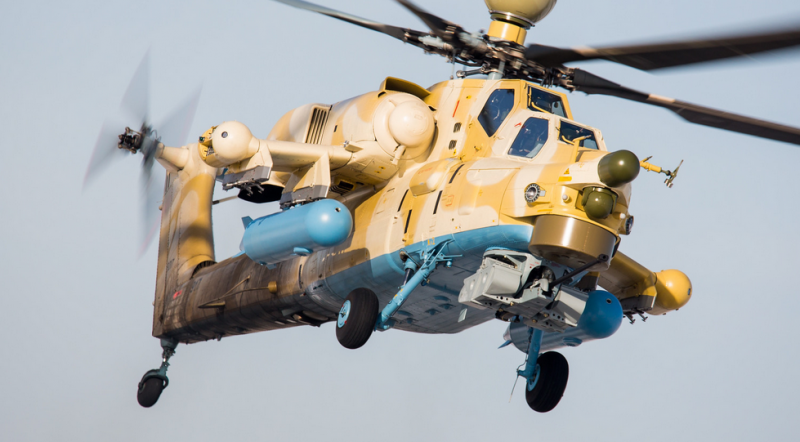
Information